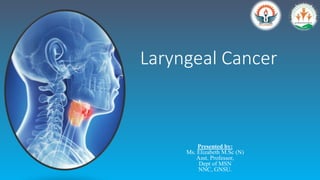
2. laryngeal Cancer - easy explanation
- 1. Laryngeal Cancer Presented by: Ms. Elizabeth M.Sc (N) Asst. Professor, Dept of MSN NNC, GNSU.
- 4. Introduction • Cancerof the larynx isamalignant tumor in andaround thelarynx (voicebox). • Squamouscentercarcinomaisthe mostcommonform of cancerof thelarynx(95%). • Cancerof the larynxoccursmorefrequently in menthanin women,andit’s mostcommon inpeoplebetweentheages of 50to 70yearsof age.
- 6. Risk factors & Causes • Tobacco and alcohol use • HPV Infection • Obesity • Poor Nutrition • Genetic • Occupational exposure • Male Gender • Age > 65 year • Race – African Americans • GERD
- 8. Pathophysiology Inflammation occurs ↑ production of secretion Obstruction of airway by mucus Hypoxia, hypercapnia
- 9. Diagnostic evaluation • Physical examination: swollen lymph nodes in the neck • Direct laryngoscopy • CT and MRI scan • Biopsy
- 10. AnIntial assessmentincludesacomplete historyandphysicalexaminationofthehead andneck. Thisincludesidentification of • risk factors • family history • anyunderlying medicalconditions
- 12. Laryngectomy - surgicalremovalof partorallofthelarynx andsurrounding structures
- 13. Partial Laryngectomy -Aportion of the larynx isremoved, along with onevocalcord andtumour Supraglotic Laryngectomy - hyoid bone, glottis and falsecordsareremoved. Hemilaryngectomy - thethyroidcartilageof thelarynxissplit in the midline of the neck,andthe portion of the vocal cord is removed Total Laryngectomy - the laryngeal structures are removed,includingthehyoidbone, epiglottis,cricoid cartilage,andtwo orthreeringsof thetrachea.
- 14. Post - Op Care: • Trachestomy tube care • Nasogastrictube feeding
- 15. Radiation Therapy The goal of radiation therapy is to eradicate the cancer and preserve the function of thelarynx. Complications from radiation therapy are acute mucositis, ulceration of the mucous membranes,Pain, Xerostomia, lossof taste, dysplasia,Fatigue, skin reactions Later complications may include laryngial necrosis,edemaandfibrosis.
- 16. Speech Therapy Esophageal Speech. To do this, take air in your mouth; trap it in throat, and then let it back out. It is like what happens when burp. As the air goes out mouth, it makes the upper parts of esophagus vibrate. esophagus is the tube that goes from mouth to stomach. This type of speech requires a lot of practice. https://youtu.be/UTLg-2N4hyw
- 17. Artificial Larynx can use an electronic device that vibrates when turned on. put the device against neck or put a small tube in mouth. Many people use this type of device first. need to practice speaking clearly so others understand. voice will sound mechanical.
- 18. Tracheoesophageal Speech • This is a long-term way to talk after a laryngectomy. • It is often done during the surgery but can happen later. • The surgeon makes a hole between airway and esophagus. • A small valve goes into this hole. breathe air in from the hole in neck and cover the hole up. • The air goes through the valve into the esophagus. The esophagus vibrates, and use that to make sounds through mouth
- 19. Complication • Respiratorydistress(hypoxia, airwayobstruction) • Hemorrhage • Infection • Woundbreakdown • Aspiration
- 20. Nursing Management • Expect initial shock and disbelief following the diagnosis of cancer and traumatizing procedures (disfiguring surgery, colostomy, amputation). Few patients are fully prepared for the reality of the changes that can occur. • Provide an open, nonjudgmental environment. Use therapeutic communication skills of Active-Listening, acknowledgment, and so on. Promotes and encourages realistic dialogue about feelings and concerns.
- 21. • Encourage verbalization of thoughts or concerns and accept expressions of sadness, anger, and rejection. Acknowledge the normality of these feelings. Patients may feel supported in the expression of feelings by the understanding that deep and often conflicting emotions are normal and experienced by others in this difficult situation.
- 22. • Be aware of mood swings, hostility, and other acting-out behavior. Set limits on inappropriate behavior, and redirect negative thinking. Indicators of ineffective coping and need for additional interventions. Preventing destructive actions enables patients to maintain control and a sense of self-esteem. • Be aware of debilitating depression. Ask the patient direct questions about the state of mind. Studies show that many cancer patients are at high risk for suicide. They are especially vulnerable when recently diagnosed and discharged from the hospital.
- 23. • Identify positive aspects of the situation. The possibility of remission and slow progression of the disease and new therapies can offer hope for the future. • Discuss ways patients and SO can plan together for the future. Encourage the setting of realistic goals. Having a part in problem-solving and planning can provide a sense of control over anticipated events. • Refer to visiting nurse, home health agency as needed, or hospice program, if appropriate. Provides support in meeting the physical and emotional needs of the patient and SO, and can supplement the care family and friends are able to give.
- 24. • Visit frequently and provide physical contact as appropriate, or provide frequent phone support as appropriate for the setting. Arrange for a care provider and support person to stay with the patient as needed. Helps reduce feelings of isolation and abandonment. • Reinforce teaching regarding disease process and treatment and provide information as appropriate about dying. Be honest; do not give false hope while providing emotional support. Patients and SO benefit from factual information. Individuals may ask direct questions about death, and honest answers promote trust and provide reassurance that correct information will be given.